
Since the first dude crawled into a cave and grunted, “Dude, this rocks,” shelter has been one of the big three human needs along with food and clothing. These days we think shelter, and we think house, something fixed and immovable, but for most of our human history we were wanderers. Portable shelters are part of our genotype.
From the felted yak fur gers of Mongolia and the huge tents of the Bedouin to the five-pound ultra-light pouches of modern backpackers, portable shelter has morphed into something very different. At some point, people went from comfort to efficiency.
Don’t get me wrong. Super-light backpacking tents are awesome for tucking into your pack for a week-long trek into the mountains. Five pounds can make a pretty cool portable cave for a few backpackers who drill holes in their toothbrushes and turn their socks inside out for two days of wear. But for comfortable long-term shelter, crawling into a nylon igloo is pretty stifling. There are other options, many of them considered anachronisms, but they’re still relevant. Today we’re going to talk about a few of the more unconventional shelters a man can make in the outdoors. These aren’t survival shelters–that’s another topic for another time; these are shelters you might willingly choose to make for yourself.
Shelter Materials and Equipment
When it comes to making shelter, there are two types of things you need: things to make the shelter, and things to keep the shelter where you put it up.
Shelter Materials
Canvas
Canvas is often considered an anachronism, associated with leaky, musty army pup tents found in Grampa’s attic and set up hastily in the backyard. The facts about canvas are much more subtle.
Canvas is durable. It can take a lot of abuse, can be bone-dry, and is often a superior material. Throw a log on the fire and send a bunch of sparks downwind into your ultralight tent and you’ll quickly see why.
The canvas used for shelters is often treated with fire resistant chemicals, so you can do more with a canvas shelter when it comes to heating, either with a campfire or a small, collapsible stove.
However, canvas is not light–at all. Traveling with a canvas shelter usually means an ulterior method of propulsion, like a canoe, dogsled, pack horse, or toboggan. They are most assuredly not for ultralight camping.
Synthetics
Nylon is a material, not a cloth. The weaves and fabrics made of nylon number in the hundreds, and all nylon is certainly not created equal. The coarser the weave, the more durable the fabric is against abrasion. Since most shelters do not require that sort of abrasion resistance, the heavier, courser weaves are almost never used except possibly as a reinforcement.
A wonderful discovery for the outdoor enthusiast showed up when I was a kid in Boy Scouts. We had a lot of nylon gear, but if we accidentally sliced it, the tear would run like a three year-old’s nose in February. The wonderful discovery was rip-stop nylon. By weaving a heavier thread through the fabric, any tear would stop at that thread (hence the name). Small tears are easy to patch. Long rips, you’re toast. Thanks, rip-stop. You changed my world.
Another wonderful discovery is much more recent. Ultralight nylon cloth was covered with a super-thin layer of silicone, and siliconized nylon was born. At 1.1 to 1.9 ounces per square yard, it doesn’t take a genius to see that a nine by nine tarp would weigh well under a pound. The upside: waterproof and super light. The downside: sewing siliconized nylon is like sewing two lasagna noodles together after dipping them in olive oil. The stuff is so slippery that all but the most skilled sewers can experience frustration.
Both canvas and synthetics have their time and place, and a smart outdoorsman uses both as appropriate.
Shelter Equipment
Stakes
With the kinds of unconventional shelters we’ll be discussing today, you need stakes and lots of ’em. The free-standing backpacking tent has a distinct advantage here, but that advantage is blown away quite literally. It sucks to watch the drama unfold as a good gust of wind takes your tent down a hillside and over a cliff like a giant synthetic tumbleweed.
There are stakes for every sort of ground: snow and ice, sand and silt, rock and scree. Snow stakes are large, flat-surfaced, and are designed to resist forces when they are fixed in place. This is accomplished either by driving them down into crusty snow or burying them. Snow stakes can be made of skis, shovels, trash can lids–basically anything that’s flat with a place to tie off.
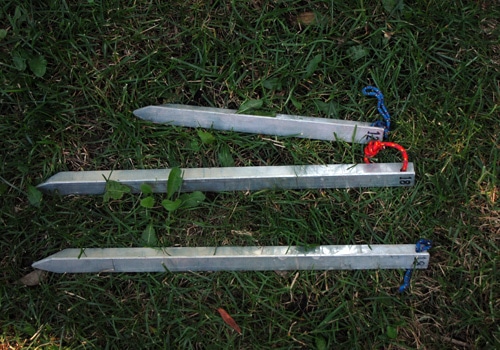
Sand stakes are similar, but sand is so dense you don’t need anything so big. Sand stakes work better as they increase in surface area, of course. I made my own because I wanted something lightweight, and I wanted to be able to make various sizes: long for high tension lines, short for staking down a non-stressed tab. I use these when pitching my lean-to on my favorite river.
We’ve all seen metal tent stakes. Small aluminum spikes work fine when the ground is firm and subsurface rocks non-existent, but they will bend into a pretzel when you hit a rock but choose to keep pounding away. Good for ultralight, but worthless in many situations. Steel stakes are better and are generally larger.
In many cases, the stakes that come with your tent are an afterthought, so consider replacing them before the trip. There are good stakes with some better brand tents, like Mountain Hardwear or MSR.
Cordage
Darren’s Outdoor Law Number 43.2: You can never have enough rope. 43.1 is The more you need a piece of cordage, the less the odds you have it with you. 43.3 is You did read 43.2, didn’t you?
All tents need cordage to stake them out properly, and as with stakes, sometimes the cord included with your tent is awful, stiff nylon rope that takes a knot when you don’t want it, and won’t when you do. Do yourself a favor and toss it. Now.
Good parachute cord is available in many sizes, colors, patterns, and materials. The cord with reflective tape woven into the sheath if wonderful, especially if you’re walking around camp at night with a headlamp.
I have 100 feet of cord in my kit at any time, usually 50 feet of regular 4 or 5mm cord and 50 of 3mm reflective.
Unconventional Shelters

Now that you have the needed materials and equipment, what can you do with them? Well many things that a great deal of campers who’ve only used a regular tent don’t know about or have never tried, but are quite useful. Let’s take a look at a few.
The Tarp
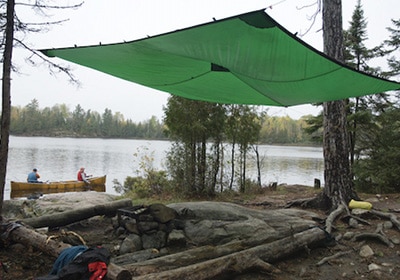
The simplest shelter of all, the tarp is incredibly versatile when pitched as appropriate for the conditions. The trick is to understand the weather patterns, prevailing winds, and the odds of inclement weather.
The most common and the simplest set-up is when you put all four corners of a tarp off the ground. Take each corner and tie it off to a tree or other tall structure, or use poles to elevate the corners. Raising the center of the tarp is necessary to allow the tarp to shed rain, or else raise one corner and lower the opposite to allow the tarp to drain. Water will run down the line attached to the lowest corner, which is sorta cool if you’re trying to collect water.
The tarp can also be configured quickly in the case of inclement weather. Sure, you can set up a tent, but in the ten minutes it takes to get the tent up, you’ll be cold, wet, and miserable. Instead, you can get a tarp rigged up in a few minutes and remain dry while you do so. The fast way is to keep a line on one corner–tie that to a tree or something else taller. Stake out the opposite corner tight, facing the wind, to make a ridge, and tack down the corners on each side of the ridge.
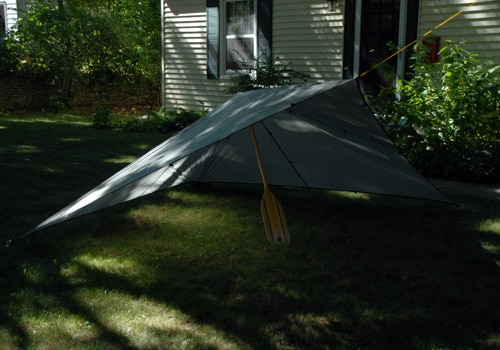
A quick pitch in case of inclement weather.
This fast pitch takes less than two minutes (I timed it this afternoon). You can support the “roof” of your shelter with a canoe paddle. If you don’t have a paddle, use a trekking pole, or the high-tech solution, a stick.
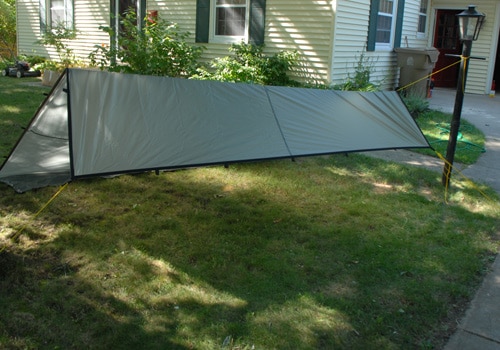
A less secure but less claustrophobic pitch is to stake down one edge of the tarp to create a wall, then angle the tarp over another line or a branch. It’s more open and requires a little more room to set up, but it’s a standard, a portable front porch from which you can watch the world go by. The higher the ridge line, the more headroom you have. You’ll notice that I tied the ridge line off to a tree and our coach light. Improvisation is the name of the tarp game.
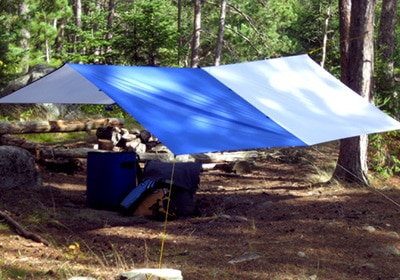
Another common pitch out in the West is what I call the tent pitch. It gets you out of sun and rain, but doesn’t do much for bugs. Just throw a line between two trees, throw the tarp over and stake down the sides. Voila, an instant A-frame. Great where there are few bugs, or if you have a bug net, or if you don’t care about being a feeding station for whatever critter sucks blood in your area of the world.
If there are no trees, you can use poles or paddles or hiking staffs instead.

The Over the Canoe Pitch
One I use fairly often is the OTC (Over The Canoe) pitch. Like the quick pitch for getting out of the weather quickly, this pitch is somewhat claustrophobic but is bomb-proof. A canoe with with a lot of curvature in the shear line and higher stems is best. Stick a paddle in the middle (your spare, most likely) to raise one side of the boat and throw the tarp over the whole thing. You are out of the weather and ready for a nasty blow, and you’re out of the weather in the time it takes to drive four stakes.
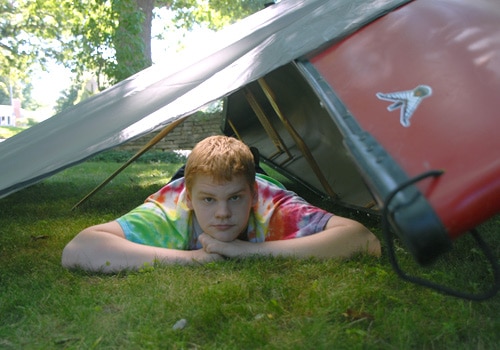
Of course, all this quick set-up stuff means you keep your tarp on the top of your pack, not buried in the bottom under your sleeping bag. You should be able to find it quickly, and with a few lines already attached, you can pitch it in minutes.
The Lean-To
The lean-to is basically a tarp on steroids. While you can rig a tarp in a lean-to style and get close, a lean-to is its own creature.
A lean-to is a three-sided tent with a small flap that makes a little roof. It can be pitched differently depending on the conditions. It can be battened down tight for a blow or left open and airy for shade from the sun. I believe it is the most versatile outdoor shelter available to humans.
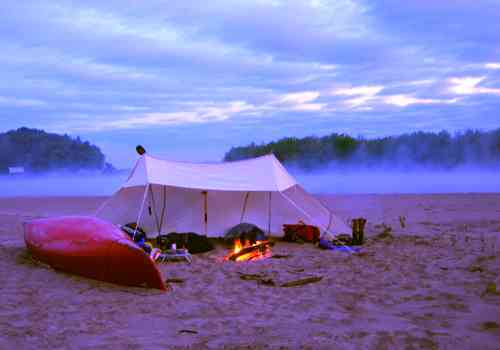 The most famous lean-to is the Whelen, designed by Army Colonel Townsend Whelen. Whelen asserted that the only two times a Whelen was inadequate was when the temperature hit 20 below or the bugs were especially heavy. I must agree with the good colonel.
The most famous lean-to is the Whelen, designed by Army Colonel Townsend Whelen. Whelen asserted that the only two times a Whelen was inadequate was when the temperature hit 20 below or the bugs were especially heavy. I must agree with the good colonel.
A few years ago I found myself on a late October solo canoe trip. The weather took a sudden turn for the worse, and I went from shirtsleeves to sleet blowing in my face and the winds building to over 30 miles an hour. I pulled off the river onto a small island with a thicket of protective trees upwind of me and pitched my lean-to as quickly as I could. It was a sandy island and I needed to use sand stakes, but I got it up and taut, back facing the howling wind. A small fire of dry aspen stripped of its bark by considerate beavers cheered things up. Inside the lean-to, all was calm and wondrous. I pulled out my stove, fried up a lamb chop with some stewed dried apples, a nice bar of chocolate and a cup of tea, and I was in paradise. If I stuck my hand above the ridgeline, I could feel the icy bullets smack into the back of my palm.
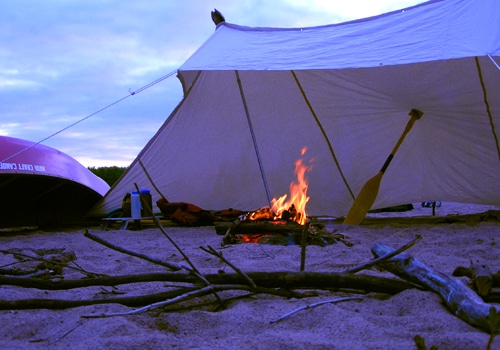
So you see, I’m partial.
With a Whelen, you can also stick a canoe up against the front for a little more shelter when it’s blowing like stink. Despite my bias, canoes are not necessary, but they sure come in handy once in a while.
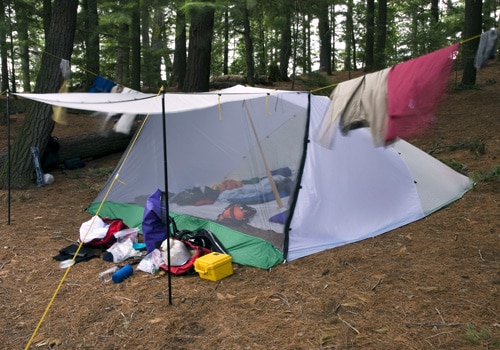
Lean-to tents are available in high-tech 1.1 ounce sil nylon, such as this one, complete with a bug net.
If you want the functionality of the lean-to and you travel to where you need a .410 to keep the mosquitoes at bay, consider a lean-to with bug netting. Synthetics are very light, and the huge door makes for great ventilation. If the weather threatens, batten down the hatches and ride it out.
The Big Gun – The Campfire Tent
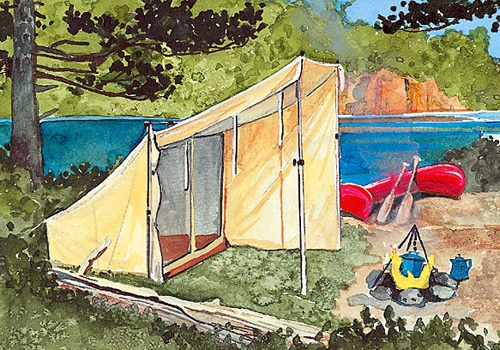
The campfire tent is clearly not ultralight. It has its place, and its place is in my canoe before May and after September, and often in-between. It was modified from the original Baker tent design by the late (and great) Bill Mason, a modern day evangelist who was responsible in part for the resurgence of a generation of paddlers. Built for him by a company in northern Ontario, the tent has become something of a legend in wilderness tripping circles for its versatility.
There is nothing lightweight about these tents. If a modern backpacking tent is a youth hostel, the campfire tent is a 4-star hotel. The ventilation, headroom, floor area, and the ability to heat it up in cold weather make this a shelter to live in.
The cotton canvas transmits light beautifully, and it will not leak once the fibers swell up. The old adage about not touching the canvas or it will leak is somewhat true, but mostly you forget about and live your life. If you must poke something, de-lint your belly button. Probably could use some attention.
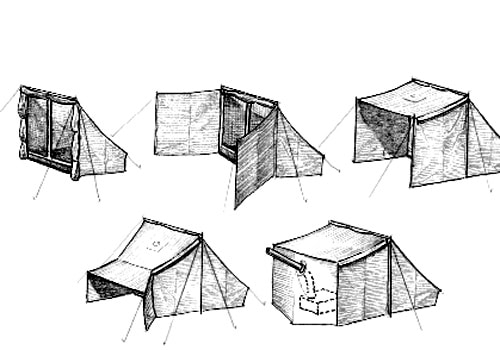
Campfire tents are extremely versatile; you can open them up as wide as a screen porch or lock things down and insert a portable camp stove, turning your tent into a snug, cozy den no matter what temperature outside.
The downside is that set-up is more difficult and takes more time. Since the walls are vertical, guy lines are critical to keeping the tent storm-worthy. Site location is also critical, so don’t expect to set this tent up in a driving rain. Jump under your tarp and wait it out. In the meantime, figure out in your head how you’re going to set up your campfire tent in one of a thousand ways.
Why a giant tent? In our climate (there is a fair amount of rain and snow), you can be storm-bound in a tent for days. If you need to spend a few days laying over and waiting for the weather to clear, would you rather wait in a 4-star hotel with a view of the lake or a bunk bed in a youth hostel with a view of the inside of your tent?
There is also the question of livability. Homo sapiens, with a few exceptions, don’t like to be confined. If you’re on the go and moving daily, perhaps this is too big of a project for you, but if you’re staying in place a few days here and there, it’s worth it. There’s nothing as luxurious as watching a storm roll across the lake while playing cribbage with your partner or reading something by Calvin Rutstrum. If you don’t know who CR is, you’re missing out. But that’s for another day.
Resources:
Frost River – for the Whelen lean-to and Campfire Tent, made right here in the U.S. (in Minnesota). My favorite shelter when there are no bugs.
Cooke Custom Sewing. For the best tarps in the outdoors, and for the super-light nylon Lean-To Plus with mosquito netting. For reference, the tarp in these pictures is a 10 x 10 1.1 ounce tarp that weighs just over a pound. All of CCS’s stuff is also made in the U.S. (also Minnesota). My favorite shelter when there are bugs. Dan tests everything he makes.


